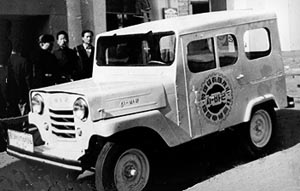|
|
| (One intermediate revision by the same user not shown) |
| Line 1: |
Line 1: |
| | [[Image:Sibal.jpg]] | | [[Image:Sibal.jpg]] |
| | | | |
| − | '''Sibal. 1955–63 (prod. 3,000 approx.). 2-door saloon. F/R, 1323 cm³ (4 cyl. OHV).''' Choi Mu-seong developed Korea’s first indigenous car with his two brothers on the basis of a [[Willys Jeep]]—parts had been left behind by the US military. Launched August 1955. Low on local content—50 per cent of its parts were imported—and initially with poor demand. Engine built by Kim Young-sam; bodies were hand-made. Its fortunes changed when the Sibal received a presidential award. Used by the élite and by taxi companies. However, with the end of subsidies, overspending by the Chois on R&D, and alliances formed with Japanese companies leading to new models, the company faltered. | + | '''Sibal. 1955–63 (prod. 3,000 approx.). 2-door saloon. F/R, 1323 cm³ (I4 OHV).''' Choi Mu-seong developed Korea’s first indigenous car with his two brothers on the basis of a [[Willys Jeep]]—parts had been left behind by the US military. Launched August 1955. Low on local content—50 per cent of its parts were imported—and initially with poor demand. Engine built by Kim Young-sam; bodies were hand-made. Its fortunes changed when the Sibal received a presidential award. Used by the élite and by taxi companies. |
| | | | |
| | | | |
Revision as of 10:43, 23 November 2013

Sibal. 1955–63 (prod. 3,000 approx.). 2-door saloon. F/R, 1323 cm³ (I4 OHV). Choi Mu-seong developed Korea’s first indigenous car with his two brothers on the basis of a Willys Jeep—parts had been left behind by the US military. Launched August 1955. Low on local content—50 per cent of its parts were imported—and initially with poor demand. Engine built by Kim Young-sam; bodies were hand-made. Its fortunes changed when the Sibal received a presidential award. Used by the élite and by taxi companies.
Manufacturing locations: Euljiro, Korea; Jongno, Korea; Yongsan, Korea
Marque: Sibal



